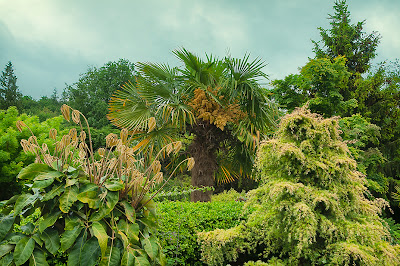 |
| Three of the Trachycarpus fortuneis in the garden |
 |
| I planted this Trachycarpus as an infant palm with no trunk. This is its size after about 18 years. |
 |
| One of the Trachycarpuses in bloom with the foliage of Schefflera delavayi in front. |
 |
| Trachycarpus with a riot of flowers growing around it. |
I have to say that unless you are truly an expert in palm identification, you cannot tell the difference between the three types. Trachycarpus wagnerianus has somewhat smaller leaves than the usual type and is a little neater in appearance than the usual type. This may be an advantage when the palm is small, but on my now over 10 foot tall specimen, it just means that the top foliage seems slightly out of proportion to the size of the plant. Not that most people would even notice.
As for Trachycarpus takil, the foliage seems a little bigger than usual, but, again, most people would not even notice. Since generally you pay a premium for the less usual T. wagnerianus and T. takil, if I were planting palms now, I wouldn't even bother to find them. I would just get the much more easily found T. fortunei.
All these palms are large specimens now, but I did not purchase any of them in any larger than 15 gal. containers, and some, including my largest T. wagnerianus, were planted from gal. containers. None of them had any noticeable trunks when I planted them. Thus, I would not recommend that anyone buy large specimen sized palms--they are very expensive and also difficult to plant because they are so large and heavy. They will grow fast enough in my opinion. Instant gratification in gardening in over-rated. Indeed, I often see Trachycarpuses here which have very skinny trunks, especially at the bottom, and which then widen toward the top. I don't care for that look. I speculate (although I don't really know for sure) that this is because they were first grown fast in a warmer climate. None of my palms have that characteristic so my hypothesis is that mine grew slower and therefore have thicker trunks.
I also have both the straight form of Chamaerops humilis and C. humilis var. cerifera in my garden. While both survive and even look good occasionally, there have been winters when they have been heavily damaged by the cold and then looked terrible for months or years. For that reason I would not plant these again in any garden of mine. I should note that these palms have been damaged in winters that have not been the coldest on record here, either. They were all planted since the big freeze of 1989-90 where we got into the single digits for days on end; and records also show that in 1950 it got down to zero degrees in the Seattle area.
Other palms I have tried that have been killed by cold winters include Rhapidophyllum hystrix, various Sabal palms, Brahea armata, Jubaea chilensis, various Washingtonias, Butea capitata and various rarer species. Since it is generally recommended that if you want to have a chance with any of these palms that you start with a relatively large specimen, and since large specimens are expensive and hard to come by here, and since you are then risking losing your very rare and expensive palm in a cold winter, I would just recommend that you stop trying to grow them here (except for Trachycarpuses) and enjoy them in Hawaii.
Excellent blog entries. i live in SW Victoria Australia. I love many plants including Trachycarpuses and Trilliums.
ReplyDeletethanks